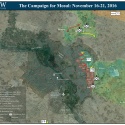 |
 |
The Campaign for Mosul: November 16-21, 2016

By Emily Anagnostos, Patrick Martin, and the ISW Iraq Team
The campaign for Mosul entered its second month, with current momentum indicating that the operation will last into January 2017. The Iraqi Security Forces (ISF) remained entrenched in eastern Mosul while facing fierce ISIS resistance from November 16 to 21, and Shi’a militias are on the outskirts of Tel Afar after seizing the nearby airbase on November 16.
The ISF has made little progress over the past week in eastern Mosul; they remain engaged in the same neighborhoods they have occupied since entering eastern Mosul on November 1.The Federal Police announced on November 19 that it had completed operations on Mosul’s southern axis and are positioning to breach the city’s southern border, where they will face an immediate fight over the airport and military base, both of which ISIS still occupies. The 16th Iraqi Army Division remains engaged in operations north of Mosul and has made no indication of a timeline to move into the city itself. Iraqi Shi’a militias advanced towards Tel Afar, west of Mosul, after retaking the nearby airbase on November 16. Ninewa Operations Commander Maj. Gen. Najm al-Juburi stated on November 19 that the 15th Iraqi Army Division advanced alongside the militias, likely in an effort to reduce possible backlash from multiple regional actors, including Turkey, that have rejected any Shi’a militia presence in the majority Turkmen town. The 15th Division’s training may also assist in the recapture of Tel Afar, as Shi’a militias have struggled to retake urban terrain without enduring heavy casualty.
The lack of progress in eastern Mosul may indicate that the Counter Terrorism Service (CTS) and Iraqi Army units have paused operationally in order to wait for ISF units nearing Mosul’s northern and southern limits. However, the CTS previously announced its pauses and has not done so now, even though the Joint Operations Command continues to issue daily operations reports. The CTS may also be deliberately slowing operations to ensure that it thoroughly clears neighborhoods before advancing or to wait for reinforcements to arrive.
More likely, the lack of progress may indicate that operations in eastern Mosul are not going as well as the Western or Iraqi media portrays. The CTS and Iraqi Army may be facing a high degree of attrition because of strong ISIS resistance slowing their advance inward. ISIS released a video on November 14 showing numerous, successful Suicide Vehicle-Borne IEDs (SVBIEDs) striking ISF units which tried and failed to stop the attack. The video also showed ISIS militants utilizing captured CTS vehicles. A field report from November 11 revealed that the CTS suffered high casualties in an effort to take al-Samah neighborhood on November 4 and could suggest that the CTS likely suffered similar casualties in following operations. The likely attrition of the CTS is extremely dangerous for the Mosul operation; the CTS is the most elite unit in the ISF and the only one with sufficient training in urban warfare. Moreover, the CTS’s participation in Mosul follows its involvement in Ramadi in January, Fallujah in June, and Qayyarah in August, giving the units limited time to regroup before tackling Mosul.
The ISF will face greater challenges as it moves into western Mosul. ISIS’s resistance in eastern Mosul was expected to be the easier fight as the majority of Mosul’s population is concentrated in the west, especially in the Old City where the maze-like, narrow streets will constrict ISF movement and vision. Several of the western neighborhoods were former areas of operation for al Qaeda, so these areas may have lasting insurgent networks capable of contesting ISF control and a population reluctant to trust government forces. The ISF’s struggle to clear eastern Mosul thus raises concern for its ability to overcome greater obstacles in the western half, especially as continued attrition will renders the force less effective.
Other ISF units will move into the city to assist this main effort, but they may not provide the needed reinforcement for the CTS or a sufficient force to hold the city. The 9th and 16th Iraqi Army Divisions operating to the north and south of Mosul, respectively, are struggling to overcome ISIS obstacles outside of the city limits and are less effective than the CTS in urban warfare. The 9th Division, as the only armored division, is also likely to deploy to western Anbar after the ISF takes Mosul. The Federal Police, moving towards Mosul’s airport from the south, are compromised by Iranian-backed Shi’a militias and have limited training in urban warfare. The use of sectarian violence by some Federal Police units will also undermine security and civilians’ trust in the ISF. Some Coalition-trained units remain in western Anbar and Baghdad, however the Iraqi Government will likely elect to keep these units in western Anbar for the inevitable operation around al-Qa’im and in Baghdad out of wariness that ISIS will strike in the capital in response to losses in Mosul.
ISIS will take advantage of these limitations of the ISF and try to resurge in the city. The ISF’s difficulty in clearing and holding a limited number of neighborhoods now indicates that it will also struggle to hold the whole city. ISIS has already shown its ability to reinfiltrate cleared cities, such as several suicide attacks in Fallujah on November 14 and 17. The holding operation in Mosul will require significant resources and manpower to ensure the city remains secure and that Salafi-Jihadi groups cannot reestablish attack capabilities in the city.